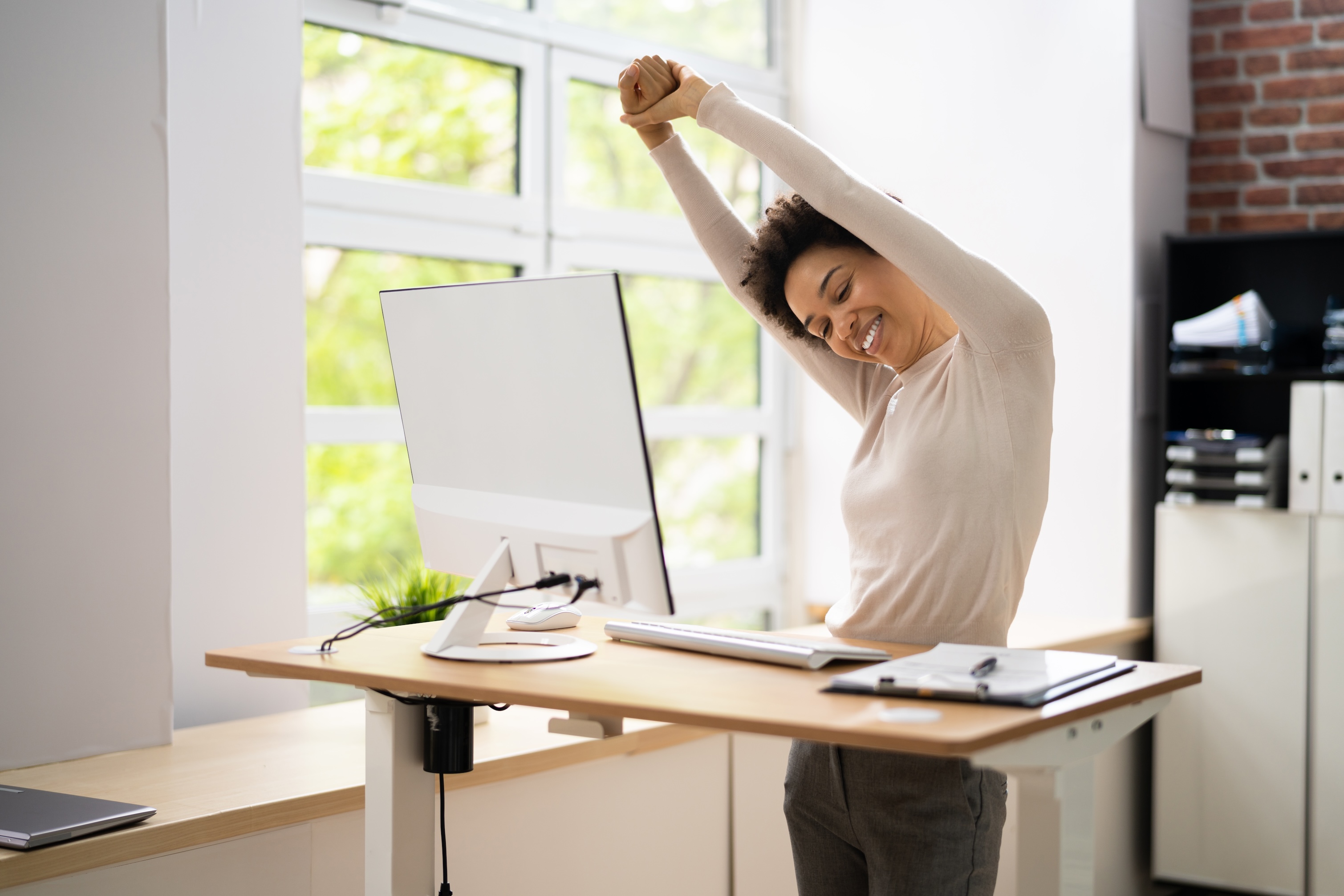Standing desks are promoted as a healthy alternative to sitting at a desk. Nonetheless, both sitting and standing are considered sedentary activities, which require little movement or energy expenditure. Indeed, standing for prolonged periods appears to carry its own health risks.
According to an October study published in the International Journal of Epidemiology (IJE), researchers found that while standing less than 2 hours per day causes no harm, it does not protect against cardiovascular events, such as heart attack and stroke.
Additionally, standing longer than 2 hours increases orthostatic circulatory disease, such as varicose veins, ulcers, and deep vein thrombosis (serious blood clot).
Sitting and standing exert different effects on the nervous system, muscles, and strain on the blood vessels. Considering the dangers of both prolonged standing or sitting, it’s important to examine potential solutions.
Explanation for Opposing Findings
Authors of the study noted that earlier investigations found that increasing standing time may improve metabolic markers of cardiovascular disease, such as total cholesterol and triglycerides. In contrast, very little research has examined the effects of sitting and standing on clinical outcomes, such as cardiovascular disease, hospitalizations, and deaths.
The majority of studies on the topic also used self-reported data, which can lead to imprecise results. Earlier studies did not differentiate orthostatic circulatory disease from other types of cardiovascular disease, such as heart attack and stroke. Moreover, prior studies measuring ambulatory activities with wearable devices did not differentiate between sitting and standing. Despite these limitations in research, public health experts have recommended standing to decrease sitting time in work environments.
To address such gaps in research, the IJE study explored a broader scope of health parameters and investigated differences between sitting and standing.
New Findings
Researchers at the University of Sydney used UK Biobank accelerometer data from 83,013 adults with an average age of 61.3 years. After following the individuals for 6.9 years,
they found that sitting longer than 10 hours per day was associated with a higher incidence of orthostatic circulatory disease risk.
The risk of orthostatic circulatory disease rose 11 percent with each 30-minute increase beyond two hours of standing.
For major cardiovascular disease, when sitting exceeded 12 hours per day, risk was higher. Importantly, standing did not mitigate this risk—a novel finding.
“The key takeaway is that standing for too long will not offset an otherwise sedentary lifestyle and could be risky for some people in terms of circulatory health,” said lead author Matthew Ahmadi, faculty of medicine and health and deputy director of the Charles Perkins Centre’s Mackenzie Wearables Research Hub, in a press release. “We found that standing more does not improve cardiovascular health over the long term and increases the risk of circulatory issues.”
The Solution
Instead of standing, the solution involves taking regular activity breaks throughout the day, Ahmadi told The Epoch Times in an email.
He said that standing didn’t translate to cardiovascular disease protection despite prior research findings that suggest it may improve metabolic markers, such as total cholesterol.
“This is likely because in order to improve our cardiovascular health, we need to engage or stimulate the cardiovascular system,” Ahmadi said. “This is most effectively done through physical activity that gets the body moving, such as going for a walk, taking the stairs, and other forms of day-to-day activities. It also includes gardening or household work that makes us move around.”
Tips for Increased Activity
To
counter sedentary health risks, the Society for Behavioral Medicine (SBM) recommends taking mini activity breaks every 30 minutes throughout the day.
Dr. Michael O. McKinney, a physician, shared the following tips in an email:
- Set a Timer for Breaks: Activities can include stretching, walking across the office, or doing some exercises.
- Walking Meetings: Whenever possible, have meetings take place while walking. This also helps improve creativity during discussions.
- Desk Exercises: Examples may include trunk and leg curls, shoulder stretches, or back twists, which can be done while sitting and give short calisthenic efforts.
- Lunch Break Activities: Part of the lunch break can be spent on a walk or a short workout. The body and mind will thank you for the break in the middle of the day.
Alternative Desks
Treadmill or cycling desks may offer better alternatives to standing desks since they involve movement. They consist of a small treadmill or stationary bike incorporated into a desk workplace. A person choosing one of these options should start slowly and take care to avoid overexertion. As with any type of exercise, it is best that people first check with their doctor.
Treadmill Desk
A
systematic review and meta-analysis published in BMC Public Health analyzed data from 13 studies involving 351 participants to determine the effect of a treadmill desk on energy expenditure, sitting time, and cardiometabolic health.
The researchers found that its use was associated with a significant boost in energy expenditure and metabolic rate. Non-significant reductions in blood pressure were also noted. This intervention provides an effective means of moderately reducing sitting time, although further research is needed to determine the effect on cardiometabolic health, the researchers concluded.
Bike Desk
A
study published in Children stated that it is vitally important to increase physical activity among children and adolescents. The researchers investigated the outcome of a cycling desk on 60 students in their fourth year of secondary education. After comparing data with a control group, the bike group showed a significant increase in physical activity. The intervention had no negative effects on academic performance.
Standing Desk With Balance Board
If a treadmill or bike is hard to incorporate into your standing desk setup, you could also use a balance board or wobble board. These are like a skateboard with a curve underneath rather than wheels. They are meant to engage core muscles and legs for increased physical activity. A
2018 study found that using a balance board led to increased calorie burn without decreasing productivity.
Exercise ‘Snacks’
It is critical to emphasize that frequent activity breaks are needed in addition to getting the proper amount of moderate-intensity exercise per week. While the World Health Organization’s recommended minimum of
150 minutes of weekly physical activity is immensely beneficial, it does not remove the adverse health risks from prolonged sitting.
In an email to The Epoch Times, Dr. Blair Suter, a cardiologist at the Ohio State University Wexner Medical Center, referred to the weekly recommendation, which people can get in 30-minute periods, five days per week, as exercise sessions. In contrast, he referred to frequent activity breaks throughout the day as exercise snacks. Both are necessary for optimal wellness.
Suter said that taking periodic movement breaks can complement exercise sessions.
“Although exercise sessions are an important part of health, exercise snacks, such as walking around the office or parking further away, are also important,” he said. “These breaks, or exercise snacks, are very beneficial for muscle movement, circulation, and metabolizing the food you eat throughout the day.”
Recap
It should be stressed that based on the IJE study, standing desks do no harm, provided their use is limited to under two hours per day. The orthostatic circulatory risk only occurs after an accumulated two-hour use.
While treadmill desks and cycling desks would increase physical activity, they might not encourage exercise breaks as often as the SBM advises. To reduce the risk of a sedentary job or lifestyle, the frequency of daily activity breaks is more important than the duration. To illustrate, treadmill walking or cycling for a minute or so every 30 minutes would break up prolonged sedentary behavior better than two 15-minute sessions per day.
The way to reduce the harmful effects of prolonged sitting is to engage in exercise snacks, whether via an alternative desk involving movement or through multiple measures such as taking the stairs.












